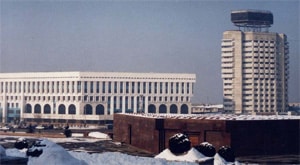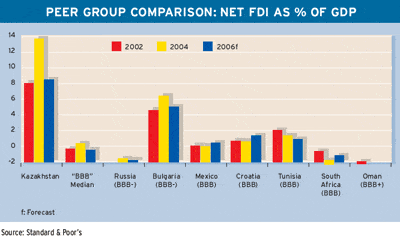The government has faced some criticism recently as a result of disputes between regulators and foreign entities with operations in the country. The disputes center on the terms included in production agreements set up between the government and certain foreign firms in the mid-1990s, among other things. This has put some slight downward pressure on FDI as investors wait to see what the outcome of such disputes will be.
Jonathan Schiffer, an analyst at Moodys, says the Kazakhstan government has taken a lot of criticism but has not done anything as yet to shake investors confidence. He explains: When the first wave of foreign investors came in the early 1990s, they were welcomed in Kazakhstan. They invested in big-name oil projects, and they also invested in mining and precious metals. As the economy found its feet, the political elite in Kazakhstan started to realize they had given very advantageous contracts to foreigners; basically they realized they had sold the crown jewels cheaply.
As a result, Schiffer says, they have started to clamp down on foreign investors. In most cases they have simply said that these contracts were highway robbery, and when they expireover the next five or 10 yearsthe terms of renewal will be much less favorable, he says. One of the most important things the Kazakhstan government has done, however, is to not break any of these existing contracts, even though many were extremely unfair to Kazakhstan.
It did cause much misunderstanding and some threats, according to Schiffer, but to date the contracts are being honored on both sides. Kazakhstan is now working on a policy to encourage light industry in order to reduce dependence on oil and gas revenues. As part of that process, the government set up the Development Bank of Kazakhstan in 2001 to help support smaller businesses. They have set up seed funds to help small rural groups to set up small business, says Schiffer, and it has worked very well, with the non-energy sector growing at about 8%. This year the bank announced plans to invest $200 million in intra-CIS projects.
According to Marchand, FDI is expected to remain high despite the difficult negotiations with major investors. Inflows reached about 13.7% of GDP in 2004 and are expected to remain at least 8% to 9% of GDP at least in the near term, he says. The main areas of interest for foreign investors continue to be, not surprisingly, oil and gas. A number of other natural resources and some of Kazakhstans industries are also attracting increasing investment. Jurgen Rigterink, chairman of ABN AMRO Kazakhstan, says: Over the past couple of years we have seen most foreign direct investment in the oil and gas, petrochemicals, metals and mining sectors. In addition, this year we have also seen some construction-related investmentsconstruction projects, cements and so on.
Outside greenfield projects, international investors have also been quite keen on picking up existing assets as they come available. For example, Kazakhmysthe largest copper producer in Kazakhstan and the 10th largest globallylaunched a highly oversubscribed IPO in October last year. The company sold a 25% stake on the London Stock Exchange, which brought in more than 600 million gross proceeds. A 15% greenshoe option was also fully exercised, which allowed the company to sell more shares than it originally offered for sale.






